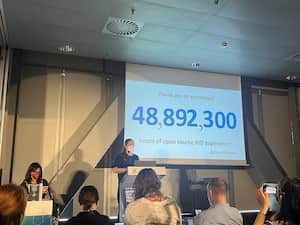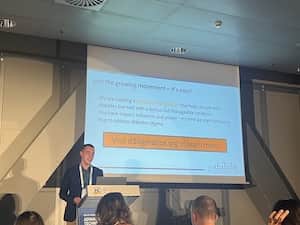What We Wish You Knew and Why: Open-Source DIY AID, Access, and Stigma
By Natalie Sainz
 At the ATTD 2022 conference, diabetes advocates delivered presentations on open-source AID, access to insulin and diabetes supplies, and diabetes stigma in the #dedocº Symposium.
At the ATTD 2022 conference, diabetes advocates delivered presentations on open-source AID, access to insulin and diabetes supplies, and diabetes stigma in the #dedocº Symposium.
It’s difficult to prepare for a life with diabetes when you are first diagnosed. There are countless medications, therapies, devices, and management techniques to learn when you are first trying to understand this condition.
Open-source or Do-It-Yourself (DIY) automated insulin delivery (AID) is one such option that could improve a person’s experience with diabetes, according to Dana Lewis, creator of the Do-It-Yourself Pancreas System (#DIYPS) and founder of the open-source artificial pancreas system movement (#OpenAPS). While not for everyone, open-source DIY AID enables people with diabetes to create and customize their own AID systems using existing technology and algorithms while tailoring it to their lifestyles.
Lewis presented the evidence and consensus on open source AID in the #dedocº Symposium on the opening day of the Advanced Technologies and Treatments for Diabetes (ATTD) 2022 conference in Barcelona, Spain. #dedoc° was founded in 2012 by Bastian Hauck, who created the Twitter hashtag #dedoc to host weekly chats for the German chapter of the Diabetes Online Community (DOC). This year, #dedocº put together the symposium, chaired by diabetes advocate Renza Scibilia, as a way to include the voices of people with diabetes at the conference.
Open-source AID
 Lewis described how she built an AID system for herself in 2014, has improved it over the years, and has been using it for herself ever since. Recognizing the significant benefits of AID, Lewis began a movement to encourage people with diabetes to build their own system. There are now thousands of people around the world who use AID and according to Leis, there are an estimated 48,892,300 recorded hours of people using open source AID.
Lewis described how she built an AID system for herself in 2014, has improved it over the years, and has been using it for herself ever since. Recognizing the significant benefits of AID, Lewis began a movement to encourage people with diabetes to build their own system. There are now thousands of people around the world who use AID and according to Leis, there are an estimated 48,892,300 recorded hours of people using open source AID.
She emphasized the potential that open-source AID has to help people with diabetes. Retrospective studies show that after switching to AID, Time in range improves, and many people find that they experience a reduction in A1C, hypoglycemia and hyperglycemia. These results also continue to improve over time for those who use the system. This evidence and data has resulted in a consensus statement on open-source automated insulin delivery, which concludes that open-source AID “is a safe and effective treatment option” that “reduces the burden of living with diabetes.”
“People with diabetes aren’t static,” Lewis said. “We are all very different. We have different lifestyles, and open-source AID is able to support that.”
However, in order to truly maximize the benefits of open-source AID, people must have access to insulin and the necessary components to create their AID system.
“The technology is here. We have scientific evidence for it, we have consensus that it’s safe and effective,” she said. “Now we need to make sure that people have the ability to access it if they choose to use it. People with diabetes can’t afford to wait.”
Access to insulin and diabetes supplies
 Access to insulin and diabetes supplies continues to be an issue and Emma Klatman, the global policy and advocacy manager at Life for a Child, discussed its importance in another presentation during ATTD 2022 titled, “I wish we all knew that access to diabetes care is a human right.”
Access to insulin and diabetes supplies continues to be an issue and Emma Klatman, the global policy and advocacy manager at Life for a Child, discussed its importance in another presentation during ATTD 2022 titled, “I wish we all knew that access to diabetes care is a human right.”
Life for a Child, a non-governmental organization, provides insulin and diabetes supplies to 45 countries across the globe and supports over 34,000 young people with diabetes, as well as doing work in research and in advocacy. As someone living with type 1 diabetes for 23 years, Klatman personally knows how vital it is that people have access to insulin and these diabetes supplies.
“Access to diabetes care is rooted in international human rights law. Far too many living with diabetes across the globe cannot rely on their government and health systems to keep them alive and thriving,” said Klatman.
While researchers and doctors work every day to improve the lives of people with diabetes, important topics like access and advocacy often get ignored.
Klatman explained that while access to diabetes care is an obvious human right, “governments do not robotically make meaningful policy out of international norms… They have to be nudged, they have to be pushed sometimes very hard to do the right thing for people with diabetes.” Due to a government’s often slow response to social and cultural norms, persistent advocacy is essential to create long-lasting change.
Diabetes stigma
However, there is one more barrier to access and to the use of helpful technology and medications that tends to be under-discussed, and that’s the stigma that people with diabetes unfairly experience. Matthew Garza, the managing editor at the diaTribe Foundation, addressed diabetes stigma during his ATTD 2022 presentation, explaining that addressing diabetes stigma is an essential missing element of diabetes care.
Put simply, “diabetes stigma exists everywhere,” Garza said.
Stigma is found in how people with diabetes are portrayed in the media, in conversations with friends and coworkers, and in the clinical setting, and even within the diabetes community. Stigma is also directly connected to how we talk about diabetes and to people with diabetes. People with diabetes are all too familiar with comments about their body weight or shame about injecting insulin and having to wear pumps on their skin.
Regardless of the source, “stigma has a real impact on mental and physical health, leading to fear, anger, low self-esteem, loneliness, and anxiety,” Garza said. Diabetes stigma can also result in worse self-management of diabetes and attempts to conceal one’s condition, ultimately resulting in worse clinical outcomes.
Recognizing the consequences of diabetes stigma motivated Garza and the rest of the team at diaTribe to launch dStigmatize.org in February 2022. The website is a comprehensive resource for understanding, reducing, and ending diabetes stigma. It explains what diabetes stigma is, why it’s harmful, and it provides personal stories and guidance on how to challenge stigma. The goal of the website is to encourage people to “create a culture of compassion that helps people with diabetes live well with a serious but manageable condition,” said Garza.
 A core component of dStigmatize is the personal stories on the site, which Garza hopes will humanize the condition and ultimately shift the narrative so that people no longer hold misconceptions about diabetes.
A core component of dStigmatize is the personal stories on the site, which Garza hopes will humanize the condition and ultimately shift the narrative so that people no longer hold misconceptions about diabetes.
The dStigmatize team also wants to focus on changing the language that people use when talking about diabetes. Research shows that the language that we use around diabetes can cause real harm. This is why Garza encouraged people to use language that is neutral, nonjudgmental, and based on facts, actions, and physiology or biology.
“Language is always evolving, and it’s time that we evolve with it,” he said.
You can watch the entire #dedocº Symposium, including the presentations from Lewis on open-source AID, Klatman on access, and Garza on stigma here.








